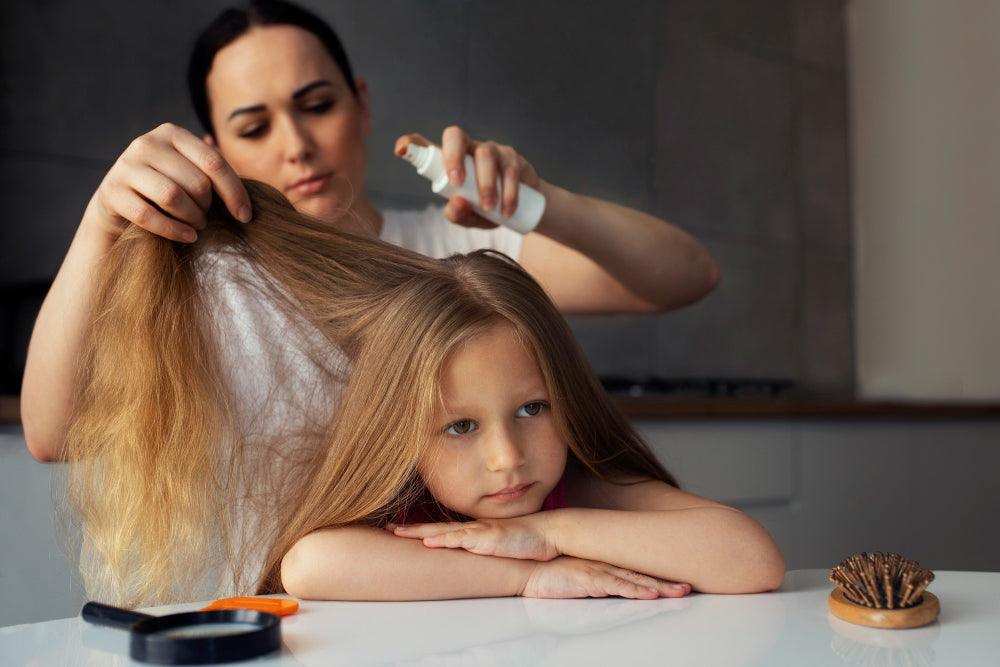Can Lice Survive a Hair Straightener?


Headlice, scientifically known as Pediculus humanus capitis, are tiny parasitic insects that infest the hair and scalp of humans. These creatures are known to have plagued humans for thousands of years, with evidence of their existence dating back to ancient civilisations. As a prevalent concern, particularly amongst school-aged children, understanding their nature and methods of infestation is crucial for prevention and treatment.
While many assume that a lice infestation suggests poor hygiene, this misconception has been debunked by numerous health experts. Dr. Amelia Richards, a renowned parasitologist from the University of Oxford, states, "Lice infestations are not necessarily an indicator of one's cleanliness. In fact, lice often prefer clean hair as it's easier for them to navigate and lay eggs."
Headlice are primary spread through direct head-to-head contact, as they cannot fly or jump. This makes close personal interactions, especially among children who play in close proximity, the leading cause of transmission. Additionally, sharing personal items like brushes, combs, or headgear can facilitate their spread. It's a misconception that lice are a result of poor hygiene; they can infest anyone's hair, regardless of how clean it is.
Head lice are wingless insects that thrive in the warmth and darkness of the human scalp. They feed on human blood several times a day. Their greyish-white or brown appearance allows them to blend seamlessly with the hair, making them difficult to spot.
The life cycle of head lice can be segmented into three stages: eggs (nits), nymph, and adult. Nits are oval and about the size of a pinhead, clinging to hair shafts. Once they hatch, they move on to the nymph stage, maturing into adults in about 10 days. Adult lice, similar in size to sesame seeds, can live up to 30 days on a human head.
It's a common misconception that head lice can jump or fly. They actually spread through direct head-to-head contact, which explains their rampant spread among children who often play in close proximity. Contrary to popular belief, Dr. Harrison Clarke, an expert in infectious diseases at King's College London, says, "Pets can't spread human lice, so it's purely a human-to-human transmission."

The treatment of head lice has evolved over the years, with numerous methods currently available.
Many over-the-counter solutions are available in pharmacies. These often contain insecticides that kill lice and nymphs but may not be as effective against nits. As with all treatments, it's crucial to follow instructions diligently. Such as the Nitty Gritty headlice comb and the Nitty Gritty Head Lice Defence Spray.
For more severe infestations or cases where over-the-counter solutions prove ineffective, doctors may prescribe stronger treatments. These are usually applied in a similar manner but contain different active ingredients. Such as Hedrin 4% spray.
Natural remedies have been employed for centuries. From vinegar rinses to essential oil treatments, many swear by their efficacy. However, their success can vary, and it's always advised to combine these methods with thorough combing.
Regardless of the chosen treatment, combing remains a vital step. Special nit combs are designed to drag nits and live lice out of the hair. Regular combing, especially post-treatment, can significantly reduce the chances of reinfestation.
Hair straighteners, commonly known as flat irons, utilise ceramic or titanium plates that heat up to specific temperatures. This heat is then applied directly to sections of hair to straighten them. Given the intense heat that some of these devices can achieve, it's reasonable to question their potential efficacy against head lice.
Dr. Elizabeth Warren, a leading entomologist from the University of Manchester, provides insight: "Hair straighteners can reach temperatures that are certainly lethal to adult lice and nymphs. However, the challenge lies in ensuring even heat distribution and reaching areas close to the scalp without causing burns."
While the intense heat from a hair straightener can kill adult lice and nymphs upon direct contact, there's a challenge when it comes to nits. The eggs, often laid close to the scalp for warmth, may not be fully exposed to the heat, especially if one avoids getting too close to the scalp to prevent burns.
Moreover, given the precision required to straighten hair, there's a risk of missing some areas, leaving them untreated. "It's a complementary method at best," states Dr. Warren, "and should be used in conjunction with other proven treatments to ensure a comprehensive approach."
Lice, like all insects, are ectothermic, meaning their body temperature is regulated by the environment. When exposed to extreme temperatures, they can become stressed and eventually die.
Research from the London School of Hygiene and Tropical Medicine found that adult lice and nymphs begin to show signs of thermal stress when exposed to temperatures above 40°C (104°F). However, the duration of exposure is crucial, with longer times increasing the likelihood of lethality.
While adult lice and nymphs are susceptible to heat, nits present a different challenge. The protective shell of the nit can insulate the developing louse from short bursts of heat. This is why methods that employ sustained heat, like professional lice treatment systems that use controlled heated air, tend to be more effective.
A common household item, the hair dryer, has also been considered as a potential weapon against lice. By producing a stream of hot air, there's speculation about its ability to exterminate these pests.
A study led by Dr. Lydia Thompson from Cambridge University found that using a hairdryer on affected areas reduced the number of live lice by approximately 55%. "While it's not a complete solution, the use of a hair dryer post-treatment can certainly aid in reducing the lice population," Dr. Thompson suggests.
Unlike hair straighteners that apply direct heat to the hair, hair dryers create a flow of hot air. This means the heat isn't as concentrated. Moreover, the motion of the dryer can blow lice away, making it less effective than initially perceived. It's a tool that, while beneficial post-treatment, shouldn't be the primary method of lice elimination.
After using a hair straightener on hair infested with lice, it's vital to clean the tool thoroughly. Any remnants of lice or their eggs might pose a risk of re-infestation. Dr. Rebecca Hughes, a prominent health expert from Birmingham, advises, "Just like combing tools, heating tools can carry remnants of lice or nits, and it's essential to disinfect them to prevent the spread."
Heat, when applied directly and for an extended period, can effectively kill adult lice and nymphs. The immediate impact of high temperatures causes dehydration, leading to their death.
While effective, heat treatments come with their challenges. There's a risk of burning the scalp or damaging the hair, especially with tools like hair straighteners. Overuse can lead to hair breakage and split ends.
Hair dyes contain chemicals, including ammonia and hydrogen peroxide, that may affect lice. These chemicals can be harmful to lice, particularly in their adult and nymph stages.
While hair dye can impact adult lice and nymphs, it's less effective against nits. The protective casing of nits can shield the developing louse from the chemicals.
Vinegar, specifically its acetic acid component, can help dissolve the protective glue that nits use to attach to hair shafts, making them easier to remove. It's less effective in killing live lice but can be a useful tool in the combing process.
A common method involves diluting vinegar with equal parts water, applying to the hair, and leaving it on for a few minutes before combing. Always ensure the solution doesn't get into the eyes, and it's recommended to do a patch test first to avoid any allergic reactions.
Nits are notoriously hard to deal with due to their adhesive properties and protective casing. Their location, close to the scalp, provides warmth necessary for their development.
Combing remains a primary method for nit removal. However, treatments that loosen the nit's grip, like vinegar or specialised shampoos, can aid the process.
There's a common myth that hairspray can suffocate lice. While hairspray can make the hair less appealing to lice, its components aren't specifically designed to kill them. Its effectiveness remains debatable and not scientifically proven.
Complete eradication requires a combination of treatments - from topical solutions to physical removal using combs. Regular checks, even post-treatment, are crucial to ensure no lice or nits remain.
Dr. Natasha Ray, a pediatrician in London, stresses the importance of follow-ups: "Post-treatment checks, ideally weekly, are crucial. Lice infestations can recur, and vigilance is key."
Lice infestations, though common, can be a significant source of discomfort and stress. While numerous treatments exist, from heat-based methods to chemical applications, a combined, thorough approach is most effective. Regular checks, even after an apparent eradication, are crucial to prevent recurrence. As always, vigilance, combined with informed treatment choices, remains the best defence against these pesky parasites.










Plus get the inside scoop on our latest content and updates in our monthly newsletter.